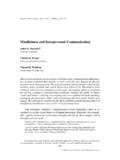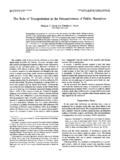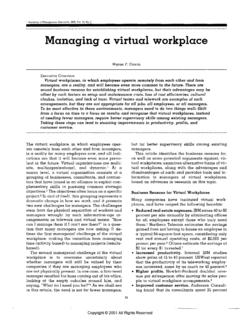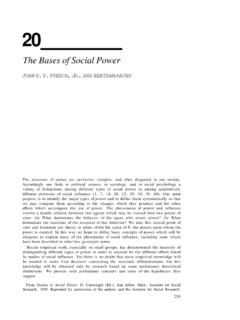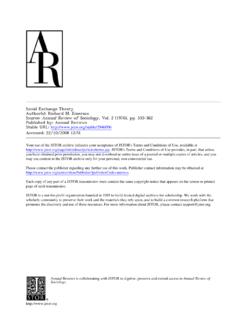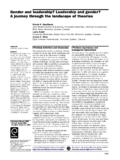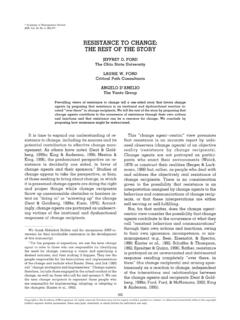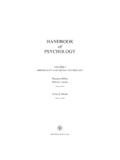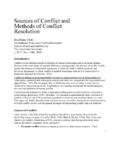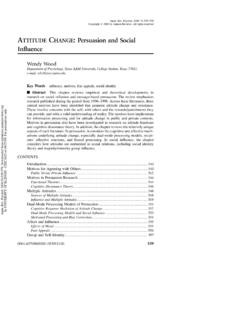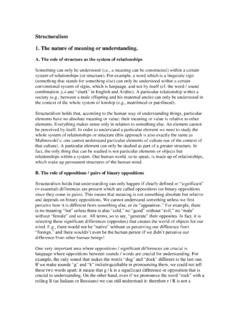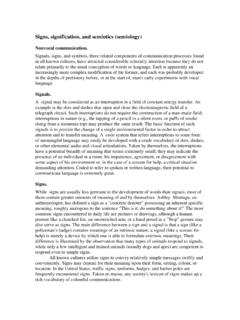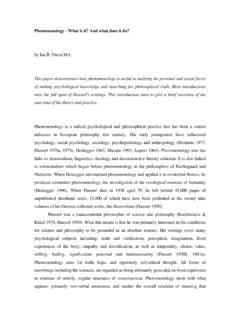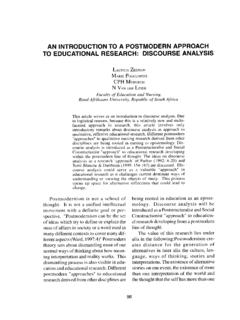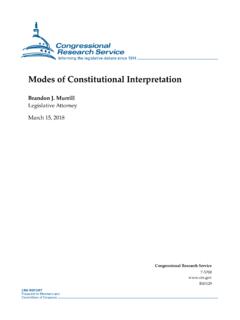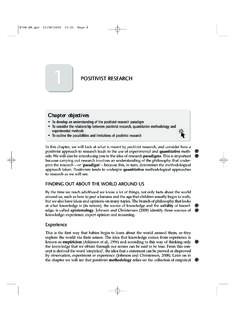Transcription of The Constitution of Society - Communication Cache
1 The Constitutionof SocietyOutline of the Theory of StructurationAnthony GiddensUniversity of California PressBerkeley and Los AngelesElements of the Theoryof StructurationIn offering a preliminary exposition of the main concepts ofstructuration theory^* it will be useful to begin from the divisionswhich have separatedJunction^sm (including systems theory)^4^tru^ur^^n_on thToiiehana^^from hermeneutics and thevarious forms of 'interpretative sociology' on the and structuralism have some notable similarities,in spite of the otherwise marked contrasts that exist betweerithem. Both tend to express a naturalistic standpoint, and both areinclined towards objectivism. FunctionaHst thought, from Comteonwards, has looked particularly towards biology as the scienceproviding the closest and most compatible model for socialscience.
2 Biology has been taken to provide a guide toconceptualizing the structure and the functioning of social systemsand to analysing processes of evolution via mechanisms ofadaptation. Structuralist thought, especiaUy in the writings ofLevi-Strauss, has been hostile to evolutionism and free frombiological analogies. Here the homology between social andnatural science is primarily a cognitive one in so far as each issupposed to express similar features of the overall Constitution ofmind. Both structuralism and functionalism strongly emphasizethe pre-eminence of the social whole over its individual parts( , its constituent actors, human subjects).In henneneutic traditions of thought, of course, the social andnatural sciences are regarded as radically discrepant. Hermeneu-tics has been the home of that 'humanism' to which structuralistshave been so strongly and persisteiitly opposed.
3 In hermeneuticthought, such as presented by Dilthey, the gulf between subjectand social object is at its widest. Subjectivity is the preconstituted References may be found on pp. 37 9.; Elements of the Theory of Structuration 3- sociologies. In structuration theory a hermeneutic starting-pointis accepted in so far as it is acknowledged that the description ofhuman .activities demands a familiarity with the forms of lifeexpressed in those activities.^t is the s^&cifically^ejagjsiveionnj)iJhe_^^ ofhuman ag^ri^_that_is Jmost_ eply iav^^^^_^^^EigI,Qf ^joc^^gractices^ Continuity of practices presumesreflexivity, but reflexivity in turn is possible only because of thecontinuity of practices that makes them distinctively 'the same'across space and time.
4 'Reflexivity' hence should be understoodnot merely as 'self-consciousness' but as the monitored characterof the ongoing flow of social life. To be_a human being is to be apurposive agent, who both has reasons for his or h^rjLCtivitiesif^^I^^^^S^^flSO^-^iS^ate discursively upon those reasons'2 Elements of the Theory of Structurationcentre of the experience of culture and history and as suchprovides the basic foundation of the social or human the realm of subjective experience, and alien to it, liesthe material world, governed by impersonal relations of causeand effect. Whereas for those schools of thought which tendtowards naturalism subjectivity has been regarded as somethingof a mystery, or almost a residual phenomenon, for henneneuticsit is the world of nature which is opaque which, unlike humanactivity, can be grasped only from the outside.
5 In interpretativesociologies, action and meaning are accorded primacy in theexplication of human conduct; structural concepts are not notablyprominent, and there is not much talk of constraint. Forfunctionalism and structuraUsm, however, structure (in thedivergent senses attributed to that concept) has primacy overaction, and the constraining qualities of structure are differences between these perspectives on social sciencehave often been taken to be epistemological, whereas they are infact also ontological. What is at issue is how the concepts of.,acti^ meaning and subjectivity should^e^pecifLe,d,,and how__they mighjLjcilate toja^onOf structure^cSS^^constramtT Ifinterpretative sociologies are founded, as it were, upon animperialism of the subject, functionalism and structuralismpropose an imperialism of the social object.
6 One of my principal-ambitions in the formulation of structuration theory is to put anend to each of these empire-building endeavours. The basicdomain of study of the social sciences, according to the theory ofstructuration, is neither the experience of the individual actor,nor the existence of any form of societal totality, bxjl socialpractices ordered acrosS-S^ce and time. Human social activities,Me some self-reproducing items in nature, are recursive. That isto say, they are not brought into being by social actors butcontinually recreated by them via the very means whereby theyexpress themselves as actors. JiLand thionghJMiiactivities make these , the sort of 'knowledgeability' displayed in nature, inthe form of coded programmes, is distant from the cognitive skillsdisplayed by human agents.
7 It is in the conceptualizing of humanknowledgeability and its involvement in action that I seek toappropriate some of the major contributions of interpretative' abqiit them). But terms such as 'purpdse''6f''intention', 'reason', 'motive''and so on have to be treated withcaution, since their usage in the philosophical literature has veryoften been associated with a henneneutical voluntarism, andbecause they extricate human action from the contextuality oftime-space. Human action occurs as a duree, a continuous flow ofconduct, as does cognition. Purposive action is not composed ofan aggregate or series of separate intentions, reasons and it is useful to speak of reflexivity as grounded in the_continuous monitoring of actioji v^ich hxrma^beiri^^^-^"expect^bthefs^to ^spiay.' t^^ reflexive'monitoring of action* depends upon"rati6nalization, understood here as a process ratherthan a state and as inherently involved in the competence ofagents.
8 An o^it^ogv oJJtlmg^P-ace as constitutive of socialI?rjpjticesjs_basicJojiiexoBeeptio -n~^^'from temporahty and thus, in one sense, 'history'.This approach can draw only sparingly upon the analyticalphilosophy of action, as 'action' is ordinarily portrayed by mostcontemporary Anglo-American writers. 'Action' is not a combina-tion of 'acts': 'acts' are constituted only by a discursive moment ofattention to the duree of lived-through experience. Nor can'action' be discussed in separation from the body, its mediationswith the surrounding world and the coherence of an acting I call a ^mtiS:Catignjriod_,&l^ of the acting self involvestreating the reflexive monitoring, rationalization and motivationof action as embedded sets of processes.^ The rationalization of4 {Elements of the Theory of Structuratlonaction, referring to 'intentionality' as process, is, like the othertwo dimensions, a routine characteristic of human conduct,carried on in a taken-for-granted fashion.}
9 In circumstances ofinteraction encounters and episodes the reflexive monitoringof action typically, and again routinely, incorporates themonitoring of the setting of. such interaction. As I shall indicatesubsequently, this phenomenon is basic to the interpolation ofaction within the time-space relations of what I shall call co-presence. The rationalization of action, within the diversity ofcircumstances of interaction, is the principal basis upon whichthe generalized 'competence' of actors is evaluated by others. Itshould be clear, however, that the tendency of some philosophersto equate reasons with 'normative commitments' should beresisted: such commitments comprise only one sector of therationalization of action. If this is not understood, we fail tounderstand that norms figure as 'factual' boundaries of social life,to which a variety of manipulative attitudes are possible.
10 Oneaspect of such attitudes, although a relatively superficial one, is tobe found in the commonplace observation that the reasons actorsoffer discursively for what they do may diverge from therationalization of action as actually involved in the stream ofconduct of those circumcstance has been a frequent source of worry tophilosophers and observers of the social scene for how can webe sure that people do not dissimulate concerning the reasons fortheir activities? But it is of relatively little interest compared withthe wide 'grey areas' that exist between two strata of processesnot accessible to the discursive consciousness of actors. The vastbulk of the 'stocks of knowledge', in Schutz's phrase, or what Iprefer to call the mz^jio/jcnow/edgejncor^^is not directly accessible to the consciousness of actors. Mostsuch knowledge is practical in character: it is inherent in thecapability to 'go on' within the routines of social life.
